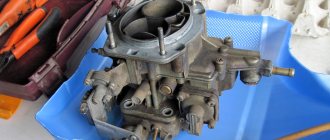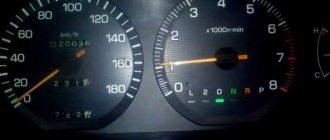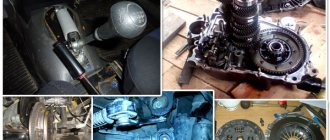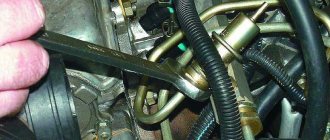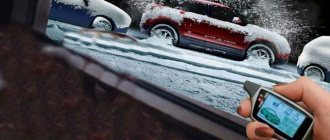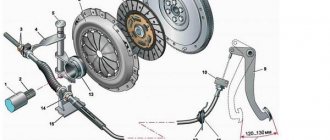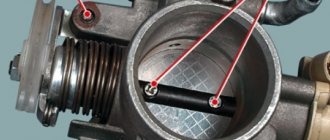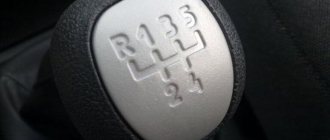Malfunctions of car components often make drivers very nervous. Engine or gearbox breakdowns can cause large unforeseen expenses, so it is better to solve problems that arise with them immediately. If the car jerks when starting off, this does not mean anything good. However, the problem may turn out to be trivial and cost a pretty penny, but it may also happen that the transmission or engine will have to be repaired. Let's figure out why the car jerks when starting off. What should you pay attention to first?
Driving style
Beginners often abruptly release the clutch pedal when starting, which is why the car jerks. There are no breakdowns here, you need to learn to drive the car by smoothly adding gas and releasing the clutch.
You need to intuitively feel at what point the clutch starts to engage. Try to practice and get moving a few times. On a car with an automatic transmission there is no clutch pedal. Therefore, to start moving smoothly, just gently press the gas, turning the gearbox into “drive” mode.
Malfunction of CV joints
On cars with front-wheel drive, torque is transmitted to the wheels through special drives - constant velocity joints. If they are worn out or out of order, there will be jerking when moving away. People call the CV joint a “grenade” because of its appearance.
The following signs can be used to determine the serviceability of grenades:
- Increased play in CV joints when moving back and forth.
- A characteristic crunch when turning sharply with the addition of gas.
- Knocks while moving.
Most often, the cause can be eliminated only by replacing the grenades, but sometimes they are sorted out and lubricated. Although this doesn't help for long. If you have an inspection hole or overpass, a standard tool, then you can do everything yourself.
Grenades are replaced in the following order:
- Remove the wheel.
- Unscrew the hub nut.
- Remove the ball joint.
- Pull out the wheel drive assembly with two grenades.
Next, you need to remove the covers, clamps and knock the CV joints off the axle shaft. New parts are installed in the reverse order.
There may be individual features of replacing grenades, depending on the make of the car.
Main causes of knocking
Depending on the nature of the knock, that’s where you need to look for the problem. But let’s look at the main places where a malfunction may occur:
- CV joints and suspension.
The hose is stuck to the support bearing - Fastening parts.
- Transmission.
- Engine.
- Timing belt
- Air conditioner.
- Brake system. Scale got between the front brake pad and the brake disc.
CV joints and suspension
Considering the condition of the roads in some cities, require a thorough diagnosis of the chassis on TO-1
First of all, you should pay attention to the sound that appears when you first turn the wheels or start the power unit. If in the first case, then the problem is definitely in the chassis and it is necessary to make a diagnosis
The causes of characteristic sounds may be the breakdown of the CV joints, the failure of the steering linkage or the wear of the steering rack, and soon the ball joint is worn out and the shock absorber strut is knocking. To determine the problem, it is recommended to drive into a pit or lift and carry out a full diagnosis. As a last resort, tug on everything and determine where the sound is coming from.
When a problem is found, it is necessary to fix it as soon as possible, because if a breakdown occurs on the road, it will be almost impossible to repair it on your own. Then only a tow truck. Diagnostics of the chassis and suspension must be done at every maintenance, and saving, as a rule, will not lead to anything good.
Fasteners
There are repeated cases when the bolts on the exhaust pipe burn out or simply break off (there can be many reasons for this phenomenon), and it rubs against the gearbox or other elements.
This can cause a characteristic knocking sound when starting off. Of course, this is not the only place where problems with fastening may arise, so it is worth stopping by the pit and conducting diagnostics.
Gearbox and automatic transmission
There may also be a problem in the gearbox that causes a characteristic knocking noise. Essentially, there are two reasons why a malfunction occurs:
- The gearbox rubs against the clutch.
- The clutch disc has a high degree of wear.
- Insufficient oil level in the manual transmission.
- Insufficient oil level in the automatic transmission.
All these reasons will entail disassembling the unit to fix the problem.
Power units
Under the hood of the diesel Duster there are 109 horsepower
First, you should look for reasons in the alternator belt and pump that could cause the knocking. First of all, these are bearings of parts. They could have fallen off, which is what actually caused the knock.
More details about bearing diagnostics:
- diagnostics and replacement of the front wheel bearing;
- diagnostics and replacement of the rear wheel bearing;
The second, more terrible option is a knocking sound inside the power unit. The reasons for this phenomenon could be the following malfunctions:
- Deformation of one or more valves.
- Carbon deposits in combustion chambers.
- Development of the camshaft.
Of course, no one talks about the crankshaft, because if it knocks, the car enthusiast will understand it immediately.
timing belt
Incorrect timing belt tension can cause a metallic knock in the engine area. To fix the problem, it is necessary to disassemble the gas distribution mechanism and check the belt tension and the condition of the roller.
Air conditioner
If the driver forgot to turn off the air conditioning and the car stood for a long time, then a characteristic short-term knock will appear when starting off. This indicates a short-term operation of the switching valve. This is due to the fact that the condenser is not yet ready for operation, and the compressor has begun to drive freon through the system. The treatment is quite simple - turn off the air conditioner and turn it on when the engine warms up.
Clutch failure
Often, jerking and jerking of the car when starting off occurs due to a clutch malfunction.
What may be faulty in the clutch mechanism:
- The driven disk is worn out (replace only).
- The disc hub is stuck on the transmission input shaft. The splines need to be cleaned. If this does not help, then replace the shaft or disk.
- The linings are worn out or their fastening is loose. The driven disk assembly is replaced.
- Window wear, broken or weakened springs. Disk replacement.
- Spring plates reduced elasticity. The driven disk must be replaced with a new one.
- The pressure plate or flywheel is scored. The clutch basket or flywheel needs to be replaced.
It is convenient to carry out repairs in a pit by lifting the front of the car. First, the starter, cardan and other parts are removed, depending on the design. After removing the gearbox, you can get to the clutch. Next, you need to remove the basket cover, flywheel parts, install a new disk and reassemble in reverse order.
AvtoVAZ explained what to do in case of vibrations and jerks when starting a LADA car
May 12, 2017 LadaOnline 96 604
Some owners of Lada Priora, Granta, Kalina or Vesta cars experience vibrations and jerks when starting to move (the car jerks). One of the reasons for this malfunction may be in the clutch. How to act in the event of such cases is indicated in the AvtoVAZ information letter.
Information letter No. 5-17 dated 01/23/17
When owners of LADA cars of the KALINA, GRANTA, PRIORA, VESTA families, equipped with a 1.6 liter engine and gearboxes 2180/2181/2182, complained about “Vibrations, jerking when starting the car”
Carry out diagnostics according to the attached methodology, Appendix 1.
If you need to replace the clutch kit:
- If the vehicle is equipped with a driven clutch disc 21703-1601130-30
, in the absence of violation of operating rules, replace the clutch kit under warranty with: pressure plate
21703-1601085-30
, driven disc
21703-1601130-31
; - If the vehicle is equipped with a driven clutch disc 21703-1601130-31
(standard installed only on LADA VESTA GFL120 (KP 21827) vehicles) or a driven clutch disc
21703-1601130-32
(standard installed only on LADA VESTA vehicles GFL110 (KP 21807)) it is necessary to draw up a CLO with a description of the work performed and act in accordance with the recommendations received in response to the CLO.
Fill out the AGO for the work performed with a description of the reasons for the non-compliance and using the defect code, 1601130-051-001 “Vibration, jerking when starting a car with AMT”
, with attachment of a photo of error codes or 0
“Vehicle vibration when starting off”
, depending on the vehicle configuration, defective part 1601130, labor intensity item in accordance with the current collection of labor intensity.
Diagnostic technique
Methodology for diagnosing a car and eliminating the defect notes “Vibration, jerking when starting the car”:
1.
Test drive to confirm the defect. Is the defect confirmed?
- YES - go to step 2:
- NO - no repair work is required.
2.
Checking for the presence of fault codes in the ECM and KURKP. Are there any fault codes?
- YES - eliminate the causes of their occurrence in accordance with the relevant technical specifications, and then proceed to step 1;
- NO - go to step 3.
3.
Are there any comments on the stability of the engine at idle and low speeds?
- YES - eliminate the comment and go to step 1;
- NO - go to step 4.
4.
Are there any leaks of working fluids (oil, coolant) in the gearbox area? Was there a risk of getting caught in the clutch?
- YES - eliminate the causes of their occurrence and go to step 5;
- NO - go to step 6.
5.
Remove the clutch. Are there any signs of oil and/or coolant on the clutch friction surfaces?
- YES - replace the clutch kit and wipe the flywheel with acetone/degreaser to remove oil and/or coolant;
- NO - go to step 6.
6.
Are there any damage to the power unit mounts?
- YES - eliminate the comments and go to step 1;
- NO - go to step 7.
7.
Are the tightening torques of the power unit mounting bolts adequate?
- YES - go to step 8;
- NO - reach the required values and go to step 1.
8.
Are the tightening torques of the bolts of the belt securing the gearbox to the engine maintained?
- YES - if there are no violations of the operating rules, replace the clutch kit;
- NO - reach the required values and go to step 1.
Note: the most obvious starting mode in which vibration appears is smooth starting on small slopes. At the same time, when starting, you must not allow the engine speed to drop below idle speed.
Let us remind you that you can determine which transmission is installed on a Lada Vesta car by the values from the fourth digit of the VIN code (GFL11 - VAZ manual transmission; GFL12 - AMT; GFL13 - Renault manual transmission).
By the way, we have already described how the clutch is replaced under warranty, as well as other AvtoVAZ regulations.
Keywords: Lada Vesta clutch | clutch Lada Kalina | Lada Granta clutch | Lada Priora clutch | gearbox Lada Vesta | gearbox Lada Kalina | gearbox Lada Granta | gearbox Lada Priora | AvtoVAZ order
6 0
Found an error? Select it and press Ctrl+Enter..
About improved clutch discs for Lada Vesta and XRAY What kind of clutch is on the Lada Vesta and XRAY and what are the reviews about it Clutch of Lada Granta, Kalina, Priora and its possible malfunctions
Steering
The steering force is transmitted to the front wheels using a special device - the steering rack. If it is faulty, then when moving away the car may jerk, and there will be vibration on the steering wheel.
When the steering tips are worn, the front wheels create jerks when braking, accelerating or starting. The steering parts must be replaced with new ones.
Clutch Troubleshooting
If the drive malfunctions, you need to replace its damaged parts: the cable, or, if the clutch release drive is hydraulic, then worn rubber cuffs, springs, hoses, or the master and slave release cylinder assembly.
It is recommended to install the entire master or slave cylinder. Replacing the rubber cuffs will only solve the problem for a short time. After all, the working surface of the liner inside the cylinder is already worn out, and it will only accelerate the wear of the new cuff. After work, be sure to bleed the hydraulic system so that there is no air left in it. Because of it, the clutch release will not work correctly. If the diaphragm spring blades or vibration limiter damper springs break, the entire clutch and basket must be replaced. When installing a new unit, be sure to center the pressure disk.
This is done using a special mandrel or transmission input shaft for that vehicle. The mandrel is inserted into the pressure plate and diaphragm spring, and only then the clutch basket is screwed to the engine flywheel. Then it is tightened well and evenly to prevent the bolts from loosening during operation.
Why does the car jerk when starting from a stop?
A machine is a complex mechanism that copes with enormous loads during operation. Therefore, you should not be particularly upset if any node fails or does not work as it should. Any car breaks down - it's only a matter of time. Drivers often complain on forums that their car jerks when starting from a stop. The reasons for this phenomenon may be different. Let's try to figure them out.
The car jerks - causes and solutions
The reasons why a Niva may twitch while driving can be different. And for the rather considerable mileage that I had to cover over several years, not only on the Niva, but also on other domestic cars, I can highlight the problems that made the car twitch when driving.
I want to say right away that the list below will probably not be complete and many VAZ 2121 owners will be able to give their thoughts on this matter. But personally in my practice I have only encountered the following:
- The first and most common case is when you refuel at a gas station with low-quality fuel. There were quite a few such cases in personal practice. I especially remember one when fuel consumption increased from the usual 11 on the highway to 25 and even more. And while driving along the highway, black smoke poured out of the exhaust pipe. It turned out that the local dealer, from whom I refueled with what I thought was gasoline, diluted it almost half with diesel fuel.
- The second reason also relates to the fuel and its composition, or more precisely, to foreign substances in the tank. Often condensation accumulates in it or, again, water gets into the tank with low-quality gasoline. When the carburetor gets enough water, the engine will naturally jerk, since it will not run on water. In this case, it is necessary to pump out all the fuel from the tank and rinse it thoroughly, and check the gasoline for the presence of water - it usually accumulates at the bottom, since it is heavier.
- Burnt contacts of the ignition system, which contribute to misfires and interruptions in engine operation. This problem can be treated either by replacing the contacts or cleaning them. Also, the distributor can break through the ground wires from the contacts, which will also cause unstable engine operation.
- Misfires can also be caused by broken high-voltage wires, faulty spark plugs or even a coil. These malfunctions are treated by replacing failed parts.
That’s probably all that I was able to remember from my personal experience in operating a Niva car and other Zhiguli models. At least there were no other symptoms with my cars. Maybe one of the owners will give their useful advice and problems that arose for them. If you have anything to add, you can add your comments below.
niva-remont.com
Riding style
Speaking about why the car jerks when starting from a stop, we need to start with the obvious. The very first and most obvious reason is a harsh clutch. If you start, add gas and suddenly release the clutch pedal, the car will definitely jerk. Therefore, first of all, you need to try to change your driving style. At a minimum, when starting off, you need to release the clutch pedal very slowly and add a little more gas. However, you shouldn't press the gas pedal too hard.
However, if with an automatic transmission the car jerks when starting, then you won’t be able to change your driving style here, because there is simply no clutch pedal. But even with a manual transmission, the problem may be different. If the car still jerks even when starting smoothly, the problem is clearly not a sudden grip of the clutch discs.
How to start on a hill.
The key point here is again the clutch pedal delay at the engagement point.
To hold the car on an incline, so as not to roll down, use either the brake pedal or the parking brake (handbrake). If, on an uphill climb, you release the clutch pedal to the grip point and hold it there, and then take your foot off the brake, the car will stand still. If the climb is steep and the car still rolls back, it’s okay, you need to press the brake again and release the clutch pedal a little more. The car will remain standing still. You need to catch the so-called balance point. Next, we gradually add gas, release the clutch pedal a little more and the car starts moving.
If the car is held on the rise with the handbrake and you need to move away (during the exam at the traffic police they ask you to move with it), then in this case the actions will be as follows:
- Depress the clutch pedal with your left foot. If the engine does not work, start the engine.
- With the clutch depressed, engage first gear.
- Smoothly depress the clutch pedal until it engages.
- At the moment of seizure, holding the clutch pedal at this point, gradually add gas so that the tachometer needle rises to approximately 1500 rpm.
- Turn off the parking brake. To do this, press the lock on the handbrake handle and lower the lever down until it stops. The car will start moving.
- Fully release the clutch pedal and gradually add gas. The car will continue moving.
- To stop, depress the clutch pedal all the way and press the brake pedal.
Well, that’s basically all you need to know about the technique of starting off. If during the start the wheels still slip (this often happens on a slippery road), it’s okay, in such a situation you need to depress the clutch pedal again and release the pedal again to the gripping point.
It may not be possible to do all this right away; it will take time to acquire the skill. And you should always remember that correct actions while driving are the basis of safe driving.
In the next, fifth part of the “Driving a Car” section, we will look at how to accelerate a car. This will require the ability to change gears. If the car has an automatic transmission, then no questions arise. The automatic transmission will do everything for you. But if the car is equipped with a manual transmission, then some skills will be required.
Until this moment, in order to move off, only first gear is enough. Shifting into other gears is also not very difficult. The order of gears for any car is in their operating manuals; you only need to remember a few rules:
- Shifting is performed only when the clutch is completely disengaged (the clutch pedal is pressed to the floor).
- Gears are switched without unnecessary effort (no need to twist the lever if it doesn’t immediately “find” its place). If the gear does not engage the first time, you need to release the clutch pedal in neutral, press it again and try again.
- When changing gears, it is necessary to hold the lever in the neutral position for approximately 0.5-1 second.
These are the requirements for gear shifting. Over time, this skill will become automatic.
Navigation through the series of articles << Driving. Part 3. PedalsCar control. Part 5. Overclocking >>
External and internal CV joints
If some suspension parts are poorly secured, then when driving (especially during a sharp start), they can cause the car to jerk. First of all, you need to check the inner and outer CV joints. The inner CV joint transmits rotational energy from the gearbox to the axle shafts and then to the wheels. This element is quite important, and if problems arise with it, it must be changed. This can be done at any service station. Features of failure of the inner CV joint are as follows:
- When destroyed, the inner CV joint becomes loose and can turn when transmitting forces, especially at the start.
- On a straight road without the smallest potholes, the inner CV joint can knock. In this case, it will seem that a dull knock is coming from the wheels.
- Outer CV joints may crunch when turning. If destroyed, they can also cause the car to jerk when starting off.
- Usually, internal CV joints simply wear out and because of this they fail. However, rarely the gearbox can cause a breakdown of this unit. This happens in cases where there is something wrong with the box itself.
- Outer CV joints can break due to impacts or careless driving on a bad road.
If your VAZ car jerks when starting from a stop, then first of all you need to check the CV joints. Often on forums when discussing a similar problem, users point to this particular node. Considering the prevalence of these cars and the cheapness of spare parts, repairing this element is unlikely to be expensive. It is worth noting that a similar problem occurs on the VAZ-2114 car. When starting off, the car jerks, but after replacing the CV joint (“grenade”), the problem disappears.
Transmission problem
The gearbox may well be the reason why the car jerks when starting off. However, there should also be other signs of a gearbox malfunction: difficulty shifting all or any one gear, a strange sound from this unit, etc. If this happens on the “mechanics”, then the problem is not so bad. In this case, the box itself can be repaired, and due to the simplicity of its design, repairs will not be so expensive. But if this problem is in the automatic transmission, then this is already serious.
The car jerks in first gear or second speed: fault diagnosis
As mentioned above, in such a situation, the first step is to gradually eliminate problems in the power supply system, ignition, as well as failures in the ECM. For example, a common reason when the car jerks at low speeds when engaging first and/or second gear is insufficient fuel/air supply to the engine or impaired mixture formation.
Various ECM sensors (Hall sensor, TPS, mass air flow sensor, etc.) can also malfunction. If everything is fine with the sensors, then you need to check the engine ECU. Quite often, the problem of jerking in 1st-2nd gear is directly related to the ignition. It is necessary to check the condition of the spark plugs and high-voltage wires, distributor and other elements on a particular machine.
As a rule, if the car drives jerkily, in relation to injection cars, specialists conduct comprehensive computer diagnostics of the engine. If such a check does not produce results or the cause is not found, then the vehicle’s transmission deserves special attention.
- So, if your car is noticeably jerky in 1st and/or 2nd gear, it is important to understand that the transmission may also be causing the car to jerk when driving. At the same time, it is easier to determine the cause in the case of a manual transmission, while various types of automatic transmissions require more serious checks.
Let's start with the manual transmission. Please note that if an inexperienced driver's car jerks in first gear when starting off, it should be taken into account that often beginners simply make mistakes when releasing the clutch, while the car itself is working properly.
To start without jerking, you need to smoothly release the clutch before the driver feels the grip point (the beginning of the transmission of torque from the engine to the wheels). After the force begins to be transmitted to the wheels and the car begins to move, you need to carefully add gas, dosing the traction with the pedal accelerator.
But jerking is usually caused by problems with the clutch on the manual transmission or its adjustments. For example, a car jerks in first and second when the clutch driven disc is badly worn, the clutch does not “close” completely, and slips. This leads to the car jerking when changing gears.
In this case, jerks most often appear precisely in “low” gears (first, second speed), when the smoothest possible operation of the clutch is needed and at the same time, through the clutch in these gears, a sufficiently large torque is transmitted from the internal combustion engine to the gearbox when accelerating the car.
- Now let's move on to automatic transmissions. First of all, you need to take into account that the quality of operation and smoothness of automatic transmission shifts will depend on the type of automatic transmission.
First of all, jerking can occur when driving with robotic gearboxes that have both one and two clutches. The fact is that the clutch of such gearboxes resembles in its design and principle of operation a conventional friction clutch of a manual transmission. Often the solution to the problem is to replace the DSG or AMT clutch, after which it is imperative to adapt the clutch (training, setting the grip point).
Also, in some cases, the culprit that the car jerks when driving in 1-2 gears may be breakdowns and malfunctions in the actuators that are responsible for the operation of the clutch in automated mode.
It should also be noted that the automatic transmission itself can “slip”, and the quality of its operation greatly depends on the level/condition of the transmission oil (ATF fluid). Jerking in automatic transmissions of this type may occur due to insufficient or overfilled oil, the use of a lubricant with unsuitable properties, etc.
Do they repair gearboxes?
In any case, you will have to go to a service station, where they will examine the car and issue a conclusion. If the automation fails, repairs will be quite expensive. However, if any gear from the mechanism breaks down, the box, in principle, can be disassembled and a separate element replaced, but this is also a rather painstaking and complex procedure, and it costs money.
Note that quite often service stations do not undertake to repair automatic transmissions at all. Often they are simply replaced, but there are craftsmen who agree to restore these units, which allows the owner to save money.
The gearbox is the main culprit for jerking when starting to move.
The gearbox becomes the main element that causes various troubles in the car, in particular jerks when starting to move. If you notice other transmission malfunctions, such as poor gear engagement or a hum from the unit during operation, you can be sure that it was the gearbox that was responsible for the jerking when starting the trip. It is interesting that for mechanics this is not so scary and expensive, but in this case the automatic machine can show the most unpleasant design features:
- failure of the automatic transmission itself can result in quite expensive repairs; you will have to perform a restoration, otherwise there will be problems;
- breakdowns of gears, their fastenings, forks and other mechanical parts of automatic transmissions are also not easy to repair; you will have to disassemble and inspect your gearbox;
- on average, the cost of simple disassembly and assembly of these components for not the most modern car models will be high; older automatic transmission designs are even more expensive;
- new CVTs, robotic boxes or other alternative automatic transmission options turn out to be very difficult to repair and require a lot of money;
- if the variator starts to jerk, it is quite possible that at a professional service they will offer you to simply replace the automatic transmission, it will not be cheap.
It should be noted that problems with the gearbox are quite difficult to repair. These units are often replaced, but you can find a repairman who will offer restoration. Most likely, you will be able to save money and make repairs. But it’s better to listen to the opinions of professionals with good service. Sometimes replacement will turn out to be a more economical and successful solution for any buyer, so deepen the diagnostics of the unit and calculate all possible options for this process.
Steering gear
If the steering mechanism is faulty, a similar problem can also occur. If the steering rack has any malfunction, it can create jerks when starting. In this case, the worn parts of the rack are simply replaced, and the problem disappears.
Also, the steering rack tips may have strong play. As a result, during a sharp start or braking, or increase in speed, so-called steering wheel wobble may occur. Bent tie rods result in a sharp jerk of the steering wheel to one side when starting off. This problem requires a quick solution.
Other elements of the steering system, including bushings and silent blocks, can cause the car to knock and jerk when driving. All this applies to the steering mechanism - it can be the reason why, for example, a GAZelle car jerks when starting off. But GAZelle is not the only brand where such breakdowns occur.
Note that problems with the steering mechanism are easier to solve than problems with the automatic transmission. However, the steering mechanism requires urgent repair for the safety of the driver and passengers.
Engine
As sad as it is to admit, a problem with the engine also occurs when such problems occur in the operation of the car. If there is really something wrong with the engine, its speed should jump during sudden jerks. The engine itself can live its own life and respond weakly to the gas pedal.
What could cause the engine to run like this:
- Wear of friction pairs, which requires major repairs. This requires a lot of investment.
- Crankshaft wear. In this case, the car should not only start to move jerkily, but also make noise and knock from the engine.
- Engine coking. In this case, decarbonization will be required, which can be done at a service station.
Note that engine-related problems are the most unpleasant and most often require a large investment.
How the system works
This feature was originally intended for vehicles with automatic transmission and owners of such models immediately appreciated its benefits. Unfortunately, HSAs are mostly installed on premium cars and SUVs.
The system is designed to reduce the risk of getting into an emergency situation when the car starts to move on a downhill road. This is especially true when stopping at a traffic light before an intersection, on a slippery road surface. In addition to the moment of start, the system will also monitor the avoidance of skidding when moving up the road and while turning at the same time.
The hill start assist system operates approximately according to the following principle:
- The driver releases the brake pedal - HSA continues to hold the car on the brake for several minutes.
- The driver presses the gas pedal - the throttle valve opens and the car moves off.
The basis for this function is dynamic stabilization. It is thanks to this that manufacturers have achieved reliable fixation of the vehicle on the road at a fairly large slope. But at the same time, we can say with complete confidence that this function is autonomous and can be installed on the car yourself.
The braking function is activated automatically as soon as the vehicle stops on a road with a slope of 5 degrees. These parameters are usually set by the manufacturer of this system, but the car owner has the opportunity to adjust the degree of rise of the road independently. During daily trips, a driver of such a model may decide that it will be more comfortable for him to drive a vehicle if the car reacts to a road slope of more (or less) than five degrees. Based on his own wishes, the car owner can adjust the HSA.
The owner of such a car needs to know that the hill start system is most often built into the ESP (ABS) unit. If the ESP and ABS units fail for any reason, the HSA will also not work. These consequences can lead to:
- Electrical fault of the units.
- The sensors that record wheel rotation are clogged.
- There are faults in the electrical wiring or sensor connectors.
- Mechanical damage to sensors.
- Natural wear of the brake pads.
- Lack of brake fluid.
- Presence of fluid between brake discs and pads.
Fuel system
If the fuel mixture is supplied to the combustion chambers of the engine in the wrong amount, jerking may occur when driving. This can happen if the car owner fills the tank with poor quality fuel or gasoline that the car is not designed for. For example, if a Euro-4 or Euro-5 engine is supplied with fuel with a high sulfur content (92 gasoline), it will wear out quickly. Some injectors may also become clogged, causing the wrong amount of fuel to be delivered. This can lead to jerking at start, but the “symptoms” can be different: loss of power, detonation, increased gas consumption.
Engine Troubleshooting
After first jacking up the engine, the old, broken cushions are unscrewed. New ones are installed in their place.
Now, if the engine is misfiring, you must first determine what the reason is. This occurs due to a bad armor wire, a defective spark plug, or wear of one contact in the breaker-distributor. In the case of an injection engine, the injector may become clogged. You can determine which cylinder is not working in a simple way - by removing the armor wire from the spark plug one by one and listening to the engine reaction. If the engine starts to work even more irregularly, then this cylinder is in order. If, after removing the armored wire, it did not react in any way, then this particular cylinder is not working. Now, having identified the non-working cylinder, you can begin to find the cause of its failure and eliminate this problem.
Problems with other elements
Quite often, Opel cars jerk when starting from a stop due to problems with the exhaust gas recirculation valve. This valve is a headache for many Opel owners with Ecotec engines. As a result of the formation of soot on the valve, it may simply become clogged, and then an incomprehensible mixture consisting of fuel, air and waste exhaust gases will enter the combustion chambers. This is fraught with loss of power, increased consumption and, possibly, jerks at start.
Therefore, it is very important to fill only high-quality gasoline, and not save on buying fuel suitable for your engine. The same can be said about oil. Under no circumstances should you fill in oil with the wrong viscosity or additives!
"Brains" of the car
A special program decides in what proportion to mix fuel with air and feed it into the combustion chambers. If the program makes an error, then the engine will receive a mixture with an incorrect air/gasoline ratio, which can also cause the car to jerk when starting off. An oversaturated or undersaturated mixture may be fed into the combustion chambers, then a batch of normal mixture may enter the system, after which improper mixing occurs again - all of which can easily cause the car to jerk, both when starting and when driving at speed. This may also be accompanied by popping noises from the exhaust pipe or lack of engine response to the gas pedal.
The engine is the most serious problem of jerking when starting to move
And the last mechanism that can create unpleasant features while driving is the engine. It is very easy to distinguish between power unit jerks and problems with the suspension or steering, or even the gearbox. This is always associated with interruptions in the operation of the power unit or jerks in speed. The engine may not obey, live its own life, which does not depend on the control systems. The main problems of the power unit are as follows:
- wear of internal mechanisms, this can become a big problem that requires a major overhaul of the power unit and the investment of a large amount of money;
- crankshaft wear - in this case, when you start to move, you will hear unpleasant knocking noises and other effects that will tell you the problem is directly with the engine;
- clogged fuel injection system, this is especially true for injectors and gasoline injectors that become clogged with low-quality fuel;
- the need for high-quality maintenance, pouring fresh and high-quality oil into the crankcase of the power unit, a complete inspection and diagnostics of the engine;
- changing gas stations - it is quite possible that jerks at the start of movement and when changing gears are associated with very low fuel quality; for many units this is normal.
Japanese engines often suffer from troubles such as jerking and rough ride. At the moment of movement, the mixture may become oversaturated, or vice versa - a lean mixture may be injected into the combustion chambers. This sometimes causes popping noises from the exhaust pipe, sometimes a delay in the engine's response. Sometimes this becomes the cause of unpleasant jerks, which are discussed in our publication today. We suggest watching a short video explaining why the clutch can affect the smoothness of the ride:
How to prevent this?
The following tips are a little banal, but effective. At a minimum, you need to fill your car with high-quality gasoline with the correct octane number. The instructions for the car must indicate what fuel should be poured into the tank.
This also applies to oil. It is necessary to use only the lubricant recommended by the manufacturer. Taking into account the presence of counterfeit oils on the market and low quality fuel, it is necessary to change oils even more often than the car manufacturer recommends. At a minimum, after 8-9 thousand kilometers the lubricant must be replaced. This will extend the life of the motor.
In general, you need to operate the car carefully. If you put a heavy load on the engine at least once and heat it up to the “red zone” on the thermometer, then problems with the engine can arise constantly. In this case, jerking when starting is far from the worst problem.
